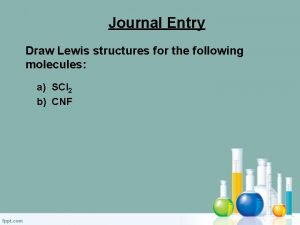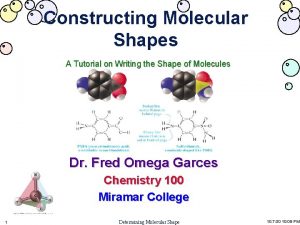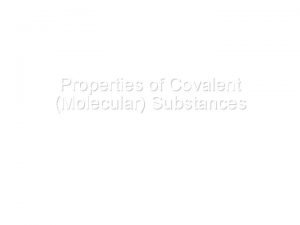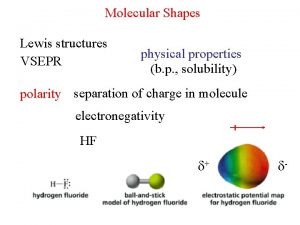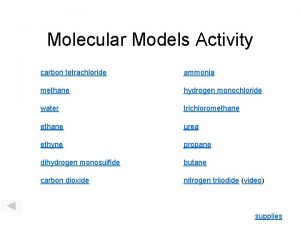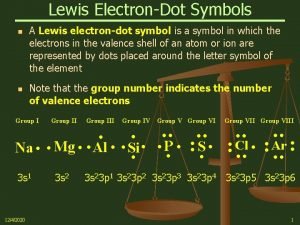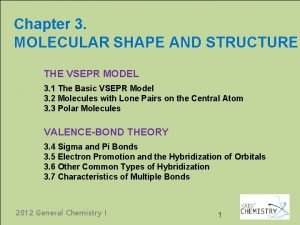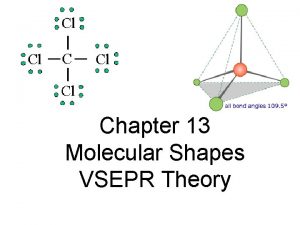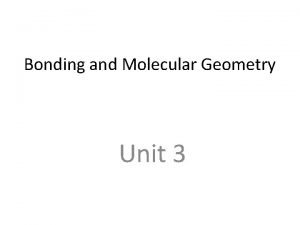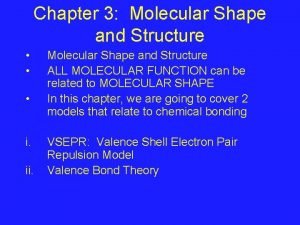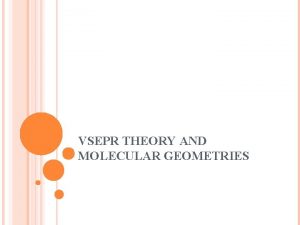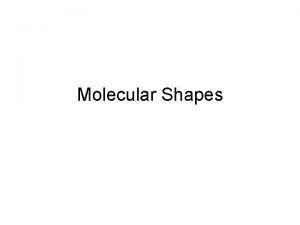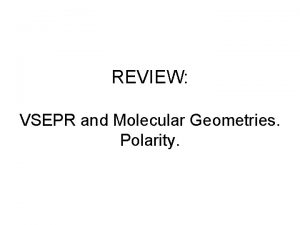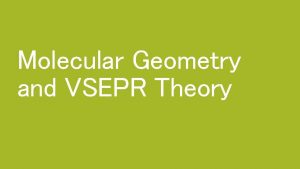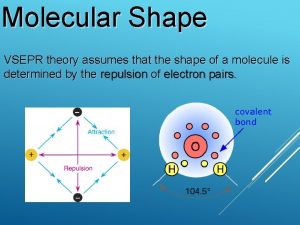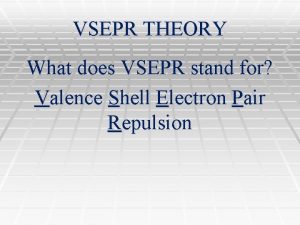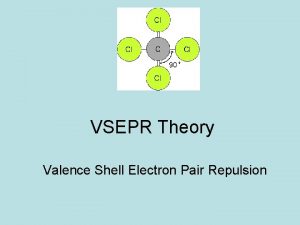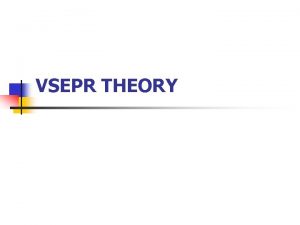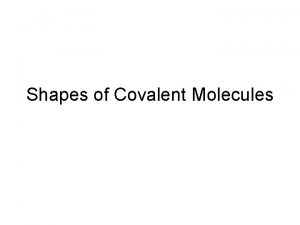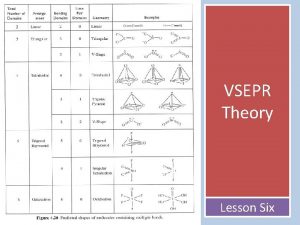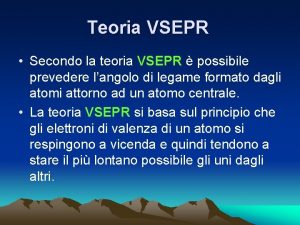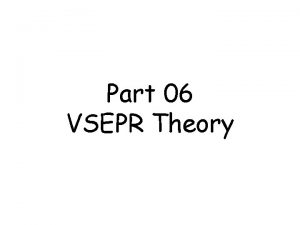Molecular Shape VSEPR Model Molecular Shape PhysicalChemical PROPERTIES




















- Slides: 20

Molecular Shape VSEPR Model

Molecular Shape Physical/Chemical PROPERTIES SHAPE of Molecule (VSEPR) Overlap of ORBITALS (Hybridization)

VSEPR Model n Lewis Structure used to determine the molecular geometry or shape. – Model used is called Valence Shell Electron Pair Repulsion model n VSEPR – based on arrangement that minimizes the repulsion of shared and unshared pairs of electrons around the central atom.

Predicting Shapes n Start with Lewis Dot structure – Show both bonding/nonbonding pairs e– Note that double and triple bonds are viewed as single bonds of e- density.

Predicting Shapes 2 pairs en 3 pairs en 4 pairs en 5 pairs en 6 pairs en Comparisons LINEAR TRIGONAL PLANAR TETRAHEDRAL TRIGONAL BIPYRAMIDAL OCTAHEDRAL http: //www. mhhe. com/physsci/chemistry/animations/chang_7 e_esp/VSEPR. swf

Molecular Shapes (routine) n Draw Lewis Structure – Focus on central atom n Count up the regions of electron density on central atom – i. e. , bonding and nonbonding pairs n Count up the number of atoms bonded to the central atom

Assign Numbers… electron density, atoms bonded Molecule CO 2 n CH 4 n NH 3 n H 2 O n Shape 2, 2 4, 4 4, 3 4, 2 linear tetrahedral pyramid bent Bond Angle 180 o 109 o 107 o 105 o

Molecular Geometry n Examples http: //www. uwosh. edu/faculty_staff/xie/tutorial/vsepr. htm#live

Hybridization n Mixing of two or more atomic orbitals of similar energies on the same atom to give new orbitals or equal energies. – Special types of atomic orbitals that have energy intermediate between s and p orbitals. Animation http: //www. mhhe. com/physsci/chemistry/essentialchemistry/flash/hybrv 18. swf More… http: //www. mhhe. com/physsci/chemistry/animations/chang_7 e_esp/bom 5 s 2_6. swf

sp 3 Hybridizaiton

Energy of sp 3 Orbitals The 2 s electron is promoted to the 2 pz orbital and the four orbitals then undergo hybridization to form four degenerate orbitals. As these new orbital have emerged from one s and three p orbitals they are called 'sp 3' orbitals.

Ammonia bonding electrons in a probability area for the hybrid orbital. . .

Geometry of Hybrid Orbitals Atomic Orbitals s, p Type of Hybrid Number of Hybrid Geometry sp 2 Linear (e- pairs) s, p, p, p sp 2 sp 3 3 (e- pairs) Trigonal Planar 4 Tetrahedral (e- pairs)

Molecular Orbitals n Sigma Bonds (s) – Two atomic orbitals combine to form a molecular orbital that is symmetricl around the axis connecting nuclei.

Sigma Bonds

Molecular Orbitals n Pi Bonds (p) – Side-by-side overlap of two p atomic orbitals produces a pi-bonding molecular orbital. – Atomic orbitals overlap less than in sigma bonding so pi (p) bonds tend to be weaker.

Hybridization and Multiple Bonds n Maximum of two electrons per orbital – So multiple bonds must include sigma (s) and pi (p) bonds. Double Bonds One s and one p n Triple Bonds One s and two p n

Formation of Sigma and Pi molecular orbitals

Molecular Orbitals

Correlation Diagram
 The basis of the vsepr model of molecular bonding is
The basis of the vsepr model of molecular bonding is How to memorize molecular geometry
How to memorize molecular geometry Octahedral bond angle
Octahedral bond angle Bond angle of nocl
Bond angle of nocl Hno3 vsepr
Hno3 vsepr Pf3 molecular geometry
Pf3 molecular geometry Vsepr theory formula
Vsepr theory formula Covalently bonded substances
Covalently bonded substances Ionic covalent metallic
Ionic covalent metallic Giant molecular structure vs simple molecular structure
Giant molecular structure vs simple molecular structure What is a covalent molecular substance
What is a covalent molecular substance Pf3 number of vsepr electron groups
Pf3 number of vsepr electron groups Ch2o lewis structure molecular geometry
Ch2o lewis structure molecular geometry Bond polarity vs molecular polarity
Bond polarity vs molecular polarity Hydrogen monochloride
Hydrogen monochloride Alxny notation
Alxny notation Ultraviolet axn
Ultraviolet axn Acetate ion lewis structure
Acetate ion lewis structure Types of molecular geometry
Types of molecular geometry Molecular shape finder
Molecular shape finder Types of molecular shapes
Types of molecular shapes



